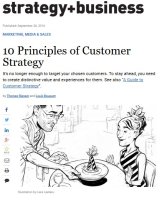
10 Principles of Customer Strategy by Thomas Ripsam and Louis Bouquet

Read the summary below and get the key insights in just 10 minutes!

What do customers want? Simply identifying a group of consumers and crafting a well-designed product for those consumers isn’t enough. Consumers today want more than product; they want companies to offer them unique experiences. To do this, businesses must have a comprehensive customer strategy in place. Strategy experts Thomas Ripsam and Louis Bouquet break down 10 principles of a winning customer strategy, offering case studies and tips to help organizations craft their own executable plans. getAbstract recommends this article to business leaders and sales and marketing strategists.
[/text_block]

- Why your business must develop its customer strategy and
- What ten principles make up the core of a good customer strategy.

To provide your customers with value and a unique experience, follow 10 principles:
“A customer strategy…is the articulation of the distinctive value and experience your company will deliver to a chosen set of customers over three to five years, along with the offerings, channels, operating model and capabilities you will need.”
“Your organization should be ‘fit for your customer’: That is to say, it should be designed to make it easy to deliver a great customer experience.”
- “Master the art of the possible” – Take inspiration from innovators like Uber and offer your customers helpful technologies before they ask for them. As Uber’s rideshare app shows, what is experimental today may prove to be a must-have in the near future.
- “Know your customers at a granular level” – To determine your customers’ most significant wants and needs, gather information on them from a number of different sources, including social media.
- “Link your company’s customer strategy to its overall identity” – Ensure that all aspects of your firm coalesce into a unique personality. For example, Apple’s identity coincides with the “sense of superiority” its products engender in its customer base.
- “Target customers with whom you have the ‘right to win’” – Rather than pursuing all possible customers, focus your energies on those consumers you feel confident will appreciate what you have to offer. Trader Joe’s, for example, pursues health-conscious food shoppers on a budget.
- “Treat your customers as assets that will grow in value” – Top companies nurture their long-term customer relationships by working to fulfill their ever-changing needs.
- “Leverage your ecosystem” – Your supply chain should serve as an outlet to attract customers. Additionally, cultivate “brand ambassadors” to promote your brand in both formal and informal settings.
- “Ensure a seamless omnichannel experience” – Apparel brand Bonobos, for example, uses physical “guideshops” to facilitate online purchases.
- “Excel at delivery” – Amazon has raised the bar for product delivery; you must, likewise, prioritize the delivery experience.
- “Reorganize around the customer” – As needed, reorganize your business, including new policies, teams and shifting roles. Build employee skills to serve the experience you wish to offer your customers.
- “Match your culture with your customer strategy” – Recognize the importance of creating, modeling and encouraging cultural behaviors that best serve your customers.
[/text_block]

Thomas Ripsam is an adviser to executives with Strategy&, PwC’s strategy consulting business. Louis Bouquet is a thought leader with Strategy& and a director with PwC US.
[/text_block]

Get key insights from 15,000+ non-fiction books at GetAbstract.com.
[/text_block]




